A crave-worthy ice-cold soup for hot days and other Persian recipes from Salamati
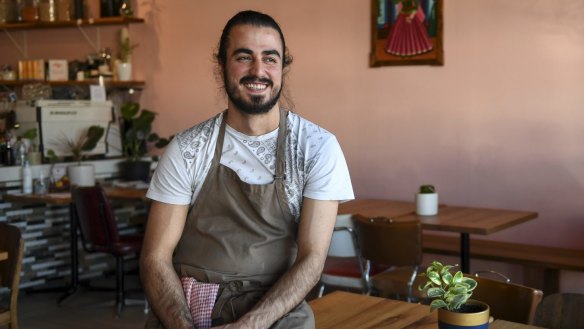
The first time I met Hamed Allahyari in early 2017, he was cooking for hundreds of workers, volunteers and refugees at the Asylum Seeker Resource Centre in Footscray. There was gentle but abundant joy in his laden platters: saffron-scented rice strewn with barberries, chopped shirazi salad with cucumber and tomato, diamond-shaped baklava, presented with pride and hope that they would engage and satisfy. It was evident that there were stories threaded through these dishes – they were so tasty and resonant – tales that connect Hamed to his Iranian birthplace but also to his new home in Australia.
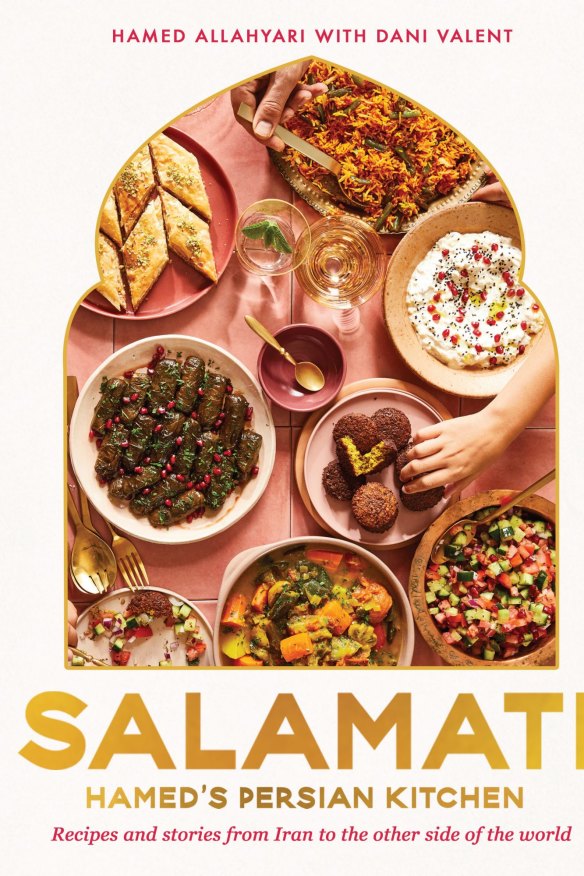
Hamed was a chef and business owner in Iran. He was also an atheist. His refusal to fall into line on religious doctrine put him in mortal danger. All of a sudden, he had to leave. With his pregnant girlfriend, he travelled to Indonesia and then by boat to Australia. It was a terrifying journey but Hamed was sure in his decision. "I would rather have been eaten by sharks than hanged in Tehran," he says. Hamed was detained on Christmas Island and finally released into the community where – after much trial and difficulty – he now runs SalamaTea, his social enterprise restaurant and cafe in Melbourne's Sunshine.
Hamed has told some of these stories in his restaurant and in hundreds of cooking classes taught with social enterprise Free to Feed. Now they are synthesised in his new book, co-written with me.
Working with Hamed Allahyari on Salamati was a happy privilege. It reinforced my notion that food stories are the best stories, the ones that transmit emotion, heart and soul, directly but with expansive context. They connect us. This book is Hamed's: the recipes and back-story are his. But the audience is all of us: ready to listen, cook and – I hope – welcome this dynamic, kind, talented refugee into an Australian community to which he's already contributed so much.
For this extract, Hamed chose recipes that are delicious and practical but also especially resonant, infused with memory. They are vessels for the story of an Iranian boy, a young rebel, an exile and now an aspiring Australian, a chef who cooks every day to belong and bring joy –Dani Valent
Abdoogh khiar (chilled yoghurt and cucumber soup)
Every hot day, I can't help but crave this ice-cold soup made with yoghurt, cucumber and herbs. In summer in Iran, I would eat it at least once a week. With the addition of dried fruit, fresh green apple and walnuts, and made extra cold with ice cubes, it's light and fresh and always looks so pretty with its colourful garnishes.
The soup can also be thickened with bread. When we soak bread in a thin soup and let it soak up the juices to help bulk it up, we call it "tilit". If you want to turn abdoogh khiar from a light snack into a main meal, tilit is how you do it. You can use plain torn bread, but fried bread is even better. If you prefer a thinner soup, replace the yoghurt with buttermilk.
Even though it's not a heavy soup, abdoogh khiar is known for making people drowsy and helping them towards an afternoon nap. It's the perfect dish to have before siesta – we call it "chort zadan" – which is still a tradition for many people in Iran. At my restaurant, I would serve lunch, then close the doors at 3.30pm, go home for a sleep and return about 5.30pm.
INGREDIENTS
- 500g Persian cucumbers, diced
- 2 green apples, cored and diced
- 1 cup (20g) mint leaves, finely chopped
- 1 cup (50g) basil leaves, finely chopped
- 1 cup (50g) dill fronds, finely chopped
- 1 cup (100g) walnuts, crushed, plus extra chopped, to serve
- 1 cup (170g) raisins
- 2 tsp salt
- 2 tsp freshly ground black pepper
- 1kg plain yoghurt
- 6-8 ice cubes
- 1 tbsp dried mint
- handful edible dried rose petals
- tilit (see recipe), to serve (optional)
METHOD
- Combine the cucumber, apple, herbs, crushed walnuts and raisins in a large bowl, then stir through the salt and pepper. Add the yoghurt and stir to combine, then add the ice cubes.
- Divide the soup among bowls and top with the dried mint, chopped walnuts and rose petals. Serve with tilit, if desired.
Serves 6–8
Noon lavash (Persian flatbread) for tilit
We eat bread for breakfast, lunch and dinner – no meal is complete without it. Flatbread is often used in place of cutlery to scoop up food, for wiping our plates clean and for wrapping anything from cheese to falafel.
There's no such thing as stale bread either! Yesterday's bread is turned into tilit (dried bread that is torn and added to soups and stews to bulk them up) or tahdig (layered bread on the base of a pot of rice that forms a crisp golden crust).
INGREDIENTS
- 2 tbsp active dried yeast
- 3 cups (450g) plain flour, plus extra for dusting
- ½ cup (125ml) vegetable oil
- 2 tsp salt
METHOD
- Combine the yeast and ½ cup (125ml) warm water in a jug, then cover and set aside for 10 minutes until frothy.
- Pour the yeast mixture into a large bowl and add the remaining ingredients along with 1 cup (250ml) water. Mix with your hands to bring the dough together, then turn out onto a lightly floured work surface and knead for 10 minutes or until you have a very smooth dough.
- Divide the dough into eight even-sized portions and roll the portions into balls. Set aside, covered with a clean tea towel, to prove for 40 minutes.
- Working with one portion at a time, roll the dough balls out on a lightly floured work surface into 1mm thick circles.
- Heat a large frying pan over high heat until very hot, then reduce the heat to low. Add one of the dough circles to the dry pan and cook, pressing the dough gently with a spatula as it puffs up and flipping regularly, for 5 minutes until lightly golden with a few crispy bits. Transfer to a plate and repeat with the remaining dough.
- If you would like a crispier bread to serve with dips, cook each side for an extra 2 minutes.
Note: To make tilit, cook the bread until very crisp, then leave out overnight, uncovered, to dry out further. We use dried bread for tilit, as it holds up well when soaked in soups and stews.
Makes 8
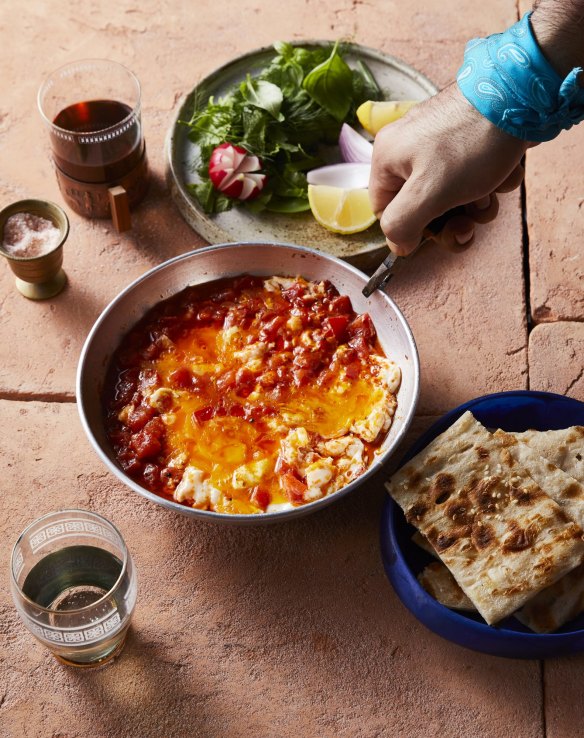
Ghahve khunee omelette (street-food tomato omelette)
I have so many fond memories of this dish. It's traditionally served in shisha shops, the cafes where older men gather to smoke water pipes, drink tea and solve the problems of the world. Shisha shops don't really serve food but inevitably people get hungry while they're hanging around, so it's become traditional for staff to whip up a quick tomato omelette for customers and serve it with bread, raw red onion, herbs and lemon.
INGREDIENTS
- 2 tbsp olive oil
- 1 tomato, diced
- 1 tbsp tomato paste
- salt and freshly ground black pepper
- 2 eggs
- noon lavash or store-bought Persian or Lebanese flatbread, to serve
- sabzi khordan (see below), to serve
METHOD
- Heat the olive oil in a small frying pan over high heat. Add the tomato and tomato paste and cook, stirring, for 2 minutes. Season with salt and pepper, then reduce the heat to low and push the mixture to one side of the pan. Crack the eggs into the now-empty side of the pan and use a spoon to gently separate the yolks from the whites. Mix the egg whites through the tomato mixture and cook for 1 minute, until the egg whites are just set. Spoon the yolks on top, then gently swirl them over the mixture and briefly cook until they are heated through but still a little runny.
- Serve the omelette in the pan or transfer to a plate, and serve with flatbread and sabzi khordan on the side.
Serves 1
Sabzi khordan (herb platter)
The classic Persian preparation of mixed greens – mostly herbs, spring onions and radishes – is sabzi khordan. My father would buy the ingredients fresh every second day and my mum would wash them and store them wrapped in paper towels inside plastic bags in the fridge. They'd then be pulled out to create this ubiquitous side dish or for a grazing platter.
INGREDIENTS
- 1 bunch radishes
- 1 bunch mint, leaves picked
- 1 bunch basil, leaves picked
- 1 bunch dill
- 1 bunch garlic chives
- 1 bunch flat-leaf parsley, leaves and stalks
- 1 bunch coriander, leaves and stalks
- 1 bunch watercress (optional)
- 1 bunch spring onions (optional)
METHOD
- Score a cross into the top half of each radish.
- Clean any dirt from the herbs, then soak all of the ingredients in a large bowl of cold water for 15 minutes. Drain, then rinse and set aside to completely dry.
- Roughly chop the herbs and spring onions into 4cm lengths, then store the herbs, spring onion (if using) and radishes, loosely wrapped in paper towel in a plastic bag in the fridge, for 2-3 days.
- Enjoy sabzi khordan with your meal or wrap with feta in Persian flatbread for a tasty lunch.
Serves 4
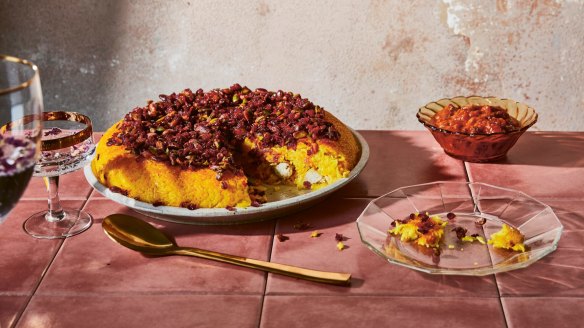
Tahchin (layered rice cake)
You can think of tahchin as a savoury cake, layered with chicken, rice and barberries. Most Persian rice dishes are all about the fluffy rice but this dish relies on mushy rice held together with yoghurt and butter. The base of the rice is cooked so it forms a crisp tahdig, and it's fragrant with saffron.
It's a little tricky to cook but the payoff is worth it and the more you make it, the easier it will be to flip it out in the perfect shape. A non-stick saucepan is a huge help.
INGREDIENTS
- 3 cups (600g) basmati rice
- 3 tsp salt
- 1¼ cups (310ml) olive oil
- 150g unsalted butter
- 2 brown onions, finely diced
- 2 tsp ground turmeric
- 1.5kg skinless boneless chicken thighs
- 2 tsp freshly ground black pepper
- 2 cups (500ml) boiling water
- 1 x quantity saffron liquid (see below)
- 1 cup (260g) Greek-style yoghurt
- 2 cups (140g) dried barberries, soaked in cold water
- ½ cup (70g) pistachio kernels, roughly chopped
Saffron liquid
- 1g saffron threads
- 1 tbsp granulated sugar
- ¼ cup (60ml) boiling water
Tomato-barberry chutney
- 2 tomatoes
- 2 tbsp tomato paste
METHOD
- Place the rice in a large bowl of cold water. Stir through 1 teaspoon of the salt and set aside to soak for 1 hour.
- Meanwhile, heat ½ cup (125ml) of the olive oil and 50g of the butter in a large saucepan over high heat. Add the onion and cook for about 2 minutes, until golden. Add the turmeric and cook for 1 minute, then add the chicken, 1 teaspoon of the remaining salt and the pepper. Reduce the heat to medium and cook the chicken, turning frequently, for 15-20 minutes, until golden brown. Add the boiling water, then cover, reduce the heat to low and cook for 10-15 minutes, until slightly reduced.
- While the chicken is cooking, grind the saffron and sugar using a mortar and pestle, then transfer to a heatproof bowl and stir through the boiling water to bleed the colour. Set aside for 5 minutes.
- Add two-thirds of the saffron liquid (leave the threads behind) and continue to cook, covered, until the liquid has evaporated. Remove the pan from the heat.
- Meanwhile, bring a saucepan of water to the boil. Drain the soaked rice and add to the boiling water with the remaining salt. Cook over high heat for 15–20 minutes, until very soft. Drain the rice and transfer to a large bowl. Add the yoghurt, 50g of the remaining butter and all of the remaining saffron liquid. Stir to combine. Drain the barberries.
- Place ½ cup (125ml) of the remaining oil and all of the remaining butter in a non-stick wide shallow saucepan and swirl the oil up the side of the pan. Add one-third of the rice mixture, then, using a slotted spoon, lay the cooked chicken on top of the rice. Add another third of the rice mixture and one-third of the drained barberries. Finish with the remaining rice and smooth the top. Set the pan over low heat, then cover and cook for 20-30 minutes.
- Meanwhile, to prepare the tomato-barberry chutney, bring a saucepan of water to the boil over high heat. Score a cross into the base of the tomatoes. Add the tomatoes to the boiling water and blanch for 1 minute, then drain and immediately plunge into a bowl of iced water. Peel the tomatoes and roughly chop.
- Add the tomato paste to the pan with the cooked onion and set over high heat. Add the chopped tomato and one-third of the remaining barberries and cook, stirring, for 10 minutes, until thickened. Remove from the heat and set aside.
- Heat the remaining olive oil in a frying pan over high heat. Add the remaining barberries and the pistachios and cook for 1 minute.
- To serve, carefully invert the rice cake onto a serving plate. Scatter the fried pistachios and barberries over the top, then cut into wedges and serve with the tomato-barberry chutney on the side.
Serves 8
This is an edited extract from Salamati by Hamed Allahyari with Dani Valent, photography by Armelle Habib. Murdoch Books, RRP $45, buy now.
Continue this series
It’s been a big year for cookbooks. Here are recipes from 50 of the bestUp next

A sweet lemon cake so simple you can make it any day of the week
This melt-and-mix number is perfect for when cake is in order, but fuss is not.
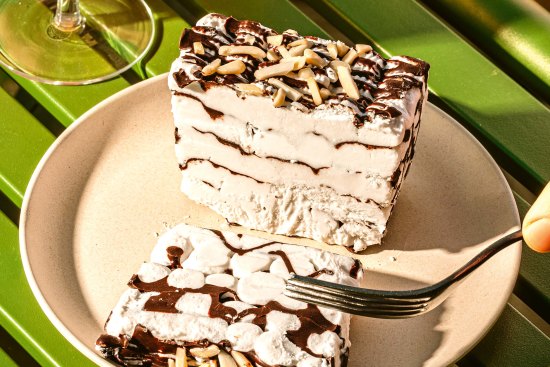
How to make a no-churn vegan Viennetta (aka veganetta) using only seven ingredients
This take on the aspirational retro classic ice-cream cake uses just a handful of ingredients and requires no churning and no cooking.
Previous
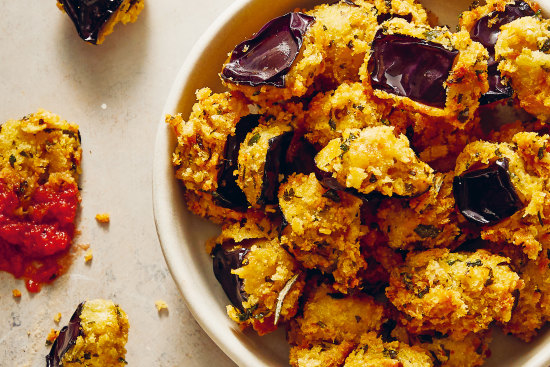
Move over chicken, popcorn eggplant makes the perfect weekend snack
Make the most of eggplant in a tomatoey pasta bake for the whole family: as crowd-pleasing crispy bites or stuffed with breadcrumbs, oregano, egg and garlic.